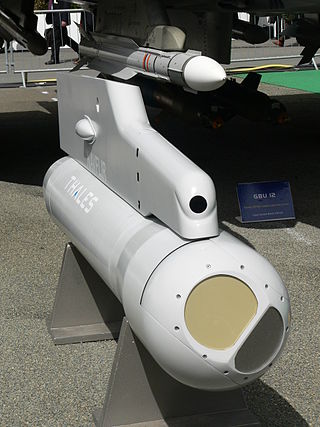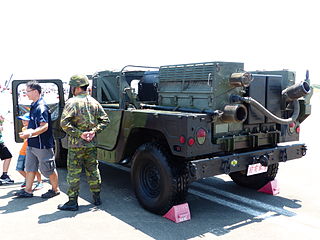
An assault gun is a type of self-propelled artillery which uses an infantry support gun mounted on a motorized chassis, normally an armored fighting vehicle, which are designed to provide direct fire support for infantry attacks, especially against other infantry or fortified positions. Assault guns were pioneered by the Soviet Union and Nazi Germany during the 1930s, initially being self-propelled guns with direct fire in mind, with Germany introducing the first purpose-built assault gun, the Sturmgeschütz III, in 1940.

A tank destroyer, tank hunter or tank killer is a type of armoured fighting vehicle, predominantly intended for anti-tank duties. They are typically armed with a direct fire artillery gun, also known as a self-propelled anti-tank gun, or missile launcher, also called an anti-tank missile carrier. The vehicles are designed specifically to engage and destroy enemy tanks, often with limited operational capacities.

The Merkava is a series of main battle tanks (MBT) used by the Israel Defense Forces (IDF) and the backbone of the IDF's Armored Corps. Current iterations of this tank are considered broadly equivalent to the capabilities of the M1 Abrams, Leopard 2 and the Challenger 2. The current iteration of this vehicle also shares the same MTU EuroPowerPack powerplant as a number of other MBT platforms.

Forward-looking infrared (FLIR) cameras, typically used on military and civilian aircraft, use a thermographic camera that senses infrared radiation.

The Bradley Fighting Vehicle (BFV) is a tracked armored fighting vehicle of the United States developed by FMC Corporation and now manufactured by BAE Systems Land & Armaments, formerly United Defense. It is named for U.S. General Omar Bradley.

The M113 is a fully tracked armored personnel carrier (APC) that was developed and produced by the FMC Corporation. The M113 was sent to United States Army Europe in 1961 to replace the mechanized infantry's M59 APCs. The M113 was first used in combat in April 1962 after the United States provided the South Vietnamese army (ARVN) with heavy weaponry such as the M113, under the Military Assistance Command, Vietnam (MACV) program. Eventually, the M113 was the most widely used armored vehicle of the U.S. Army in the Vietnam War and was used to break through heavy thickets in the midst of the jungle to attack and overrun enemy positions. It was largely known as an "APC" or an "ACAV" by the allied forces.

A smoke screen is smoke released to mask the movement or location of military units such as infantry, tanks, aircraft, or ships.
M58 or M-58 may refer to:

Heavy Industries Taxila, is a state-owned enterprise and a defense contractor located in Taxila, Punjab, Pakistan.

The K200 KIFV is a South Korean armored personnel carrier, originally produced by Daewoo Heavy Industries as a domestic replacement for older armored personnel carriers, such as the M113, in front line service with the Republic of Korea Armed Forces at the time of the K200's development. Since 2009 the K200 has been supplemented by the K21. A total of 2,383 K200 vehicles of all configurations were produced between 1985 and 2006, among which are 111 K200A1 vehicles exported to Malaysia.

The AIFV is a US tracked light armored vehicle that serves as an infantry fighting vehicle (IFV) in the armies of several countries. It is a development of the M113A1 armored personnel carrier.
A huge number of M113 Armored Personnel Carrier variants have been created, ranging from infantry carriers to nuclear missile carriers. The M113 armored personnel carrier has become one of the most prolific armored vehicles of the second half of the 20th century, and continues to serve with armies around the world in many roles.

The M901 ITV is an American armored vehicle introduced into service in 1979, and designed to carry a dual M220 TOW launcher. It is based on the M113 Armored Personnel Carrier chassis. The M901 ITV is no longer in service with the United States Army, its primary user.

The Wolf Armoured Vehicle is an armoured personnel carrier, used mainly by the Israeli Defence Force. It was created to provide a better handling and better protected armoured vehicle than the M113 (Bardelas). The Wolf is a heavily armoured crew carrier, manufactured by the company Carmor. It combines a commercial truck's speed and maneuverability and APC-like armour, qualities necessary for low-intensity confrontation. The Wolf's chassis is based on a Ford F-550 truck, and is equipped with a 6-litre V8 engine capable of reaching 325 horsepower. The engine is combined with a 5-speed automatic transmission, which drives all four wheels, making this a four-by-four.
Akrep ("Scorpion") is a Turkish infantry mobility vehicle developed by Otokar Otobus Karoseri Sanayi AS. The first prototypes were completed in May 1993 and the first vehicles came off the production line in June 1994. In addition to light reconnaissance, the vehicles were used for escort, perimeter control, counterinsurgency, and light attack. The Akrep represented the latest offering in Otokar's portfolio of light vehicles for both civilian and military markets.

The M2 Bradley, or Bradley IFV, is an American infantry fighting vehicle that is a member of the Bradley Fighting Vehicle family. It is manufactured by BAE Systems Land & Armaments.
The Armored Systems Modernization (ASM) was a U.S. Army combat vehicle procurement program canceled in 1992. The Army sought to develop a family of six armored vehicles based on two common chassis, one heavy and one medium, which would both share commonalities. Systems that the ASM sought to replace included the M1 Abrams main battle tank, M109 howitzer and M2 Bradley infantry fighting vehicle. The Army spun out several of the systems—Advanced Field Artillery System, Line-of-Sight Anti-Tank and the Armored Gun System—after canceling the program, but all of these programs were eventually canceled.

The M56 Coyote is both a separate technology and a variant of the High Mobility Multipurpose Wheeled Vehicle (HMMWV). It is used to create smoke on a battlefield.














